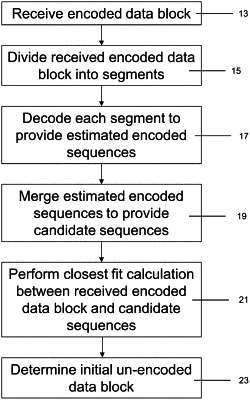| CPC H03M 13/451 (2013.01) [H03M 13/235 (2013.01); H03M 13/3972 (2013.01); H04L 1/0054 (2013.01); H04L 1/0059 (2013.01)] | 9 Claims |

|
1. A method of decoding convolutionally encoded telecommunications data, the method comprising the following steps:
receiving a convolutionally encoded data block having a plurality of values;
dividing the received convolutionally encoded data block into a plurality of received segments, each received segment comprising at least two of the values;
decoding each received segment by providing, for each received segment, a plurality of estimated encoded sequences, each estimated encoded sequence comprising at least two data units;
merging estimated encoded sequences for consecutive segments to provide a plurality of candidate sequences; and,
selecting one of the plurality of candidate sequences by performing a closest fit calculation between the received encoded data block and each of the candidate sequences,
wherein the step of providing a plurality of estimated encoded data sequences comprises:
providing, for each received segment, a plurality of estimated input sequence segments, each estimated input sequence segment comprising at least two data units, and calculating the plurality of estimated encoded data sequences by applying a coding model to the plurality of estimated input sequence segments;
wherein the merging comprises:
for each estimated encoded data sequence:
identifying an initial residual data unit combination representing the data units that would be residual in a coder memory when the first data unit of the corresponding estimated input sequence segment enters the coder, and
identifying a final residual bit combination representing the data units that would be residual in the coder memory when the first data unit of the subsequent estimated input sequence segment enters the coder, and
matching the final residual bit combinations corresponding to the estimated encoded data sequences for one received segment, to the initial residual bit combinations corresponding to the estimated encoded data sequences for the subsequent received segment.
|